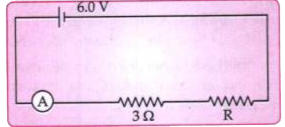A toster and a light bulb-connected in parallel. The toster produces more heat than bulb, then the resistance of toaster is:
greater than that of the bulb
equal to that of the bulb
less than that of the bulb
no comparable to that of the bulb
To solve the problem, we need to analyze the relationship between power, resistance, and heat generation in the toaster and the light bulb connected in parallel.
1. Understanding the Parallel Connection:
- In a parallel circuit, all components share the same voltage. Therefore, both the toaster and the light bulb are subjected to the same voltage (V).
2. Using Joule's Law:
- According to Joule's law, the power (P) dissipated in a resistor is given by the formula:
P=V2R
- Here, P is the power, V is the voltage across the resistor, and R is the resistance.
3. Power Comparison:
- For the toaster (let's denote its resistance as R1):
P1=V2R1
- For the light bulb (let's denote its resistance as R2):
P2=V2R2
4. Given Condition:
- It is given that the toaster produces more heat than the bulb, which means:
P1>P2
5. Relating Power and Resistance:
- Since both devices are connected to the same voltage, we can compare their powers:
V2R1>V2R2
- We can simplify this inequality (assuming V2 is positive and non-zero):
1R1>1R2
6. Inverting the Inequality:
- Inverting both sides of the inequality (and remembering to flip the inequality sign):
R1<R2
7. Conclusion:
- Therefore, the resistance of the toaster (R1) is less than the resistance of the bulb (R2). Thus, the correct answer is:
The resistance of the toaster is less than that of the bulb.
Final Answer:
The resistance of the toaster is less than that of the bulb (Option C).
---
- In a parallel circuit, all components share the same voltage. Therefore, both the toaster and the light bulb are subjected to the same voltage (V).
- According to Joule's law, the power (P) dissipated in a resistor is given by the formula:
P=V2R
- Here, P is the power, V is the voltage across the resistor, and R is the resistance.
- For the toaster (let's denote its resistance as R1):
P1=V2R1
- For the light bulb (let's denote its resistance as R2):
P2=V2R2
- It is given that the toaster produces more heat than the bulb, which means:
P1>P2
- Since both devices are connected to the same voltage, we can compare their powers:
V2R1>V2R2
- We can simplify this inequality (assuming V2 is positive and non-zero):
1R1>1R2
- Inverting both sides of the inequality (and remembering to flip the inequality sign):
R1<R2
- Therefore, the resistance of the toaster (R1) is less than the resistance of the bulb (R2). Thus, the correct answer is:
The resistance of the toaster is less than that of the bulb.
The resistance of the toaster is less than that of the bulb (Option C).
Similar Questions
The figure shows a circuit.
When the circuit is switched on, the ammeter reads 0.5A.

Calculate the value of the unknown resistor R.View Solution60 W- 220 bulb and 100 W- 220 V bulb are connected in parallel to main supply . Which bulb will draw more current ?
View SolutionAssertion: Two electric bulbs of 50 and 100W. Are given. When connected in sereis 50W bulb glows more but when connected parallel 100 W bulb glows more.
Reason : In series combination, power is directly proportional to the resistance of circuit. but in parallel comb ination, power is inversely proportional to the resistance of the circuit.View SolutionTwo bulbs, when connected in series, are brighter than a single bulb.
View SolutionThe ratio of distance of two satellites from the centre of earth is 1 : 4. The ratio of their time periods of rotation will be :
View SolutionAn air core coil and an electric bulb are connected in series with an AC source. If an iron rod is put in the coil, then the intensity of light of the bulb will
View SolutionIf electric bulbs having resistances in the ratio 2 : 3 are connected in parallel to a voltage sources of 220 V. The ratio of the power dissipated in them is
View SolutionIn a experiment , N identical electrical bulbs, each having resistance R , are connecteed in parallel to a dc source of emf E and internalresistance r . What is the power consumed by each bulb . Also find the percentage change in power by each bulb if one bulb turns out.
View SolutionWhen two electric bulbs of 40W and 60W are connected in parallel, then the:
View SolutionThree identical bulbs are connected in parallel across an ideal sources of emf E .The ammeter A and voltmeter V are ideal . If bulb B3 gets fused, then
_PHY_E05_094_Q01.png) View Solution
View Solution

